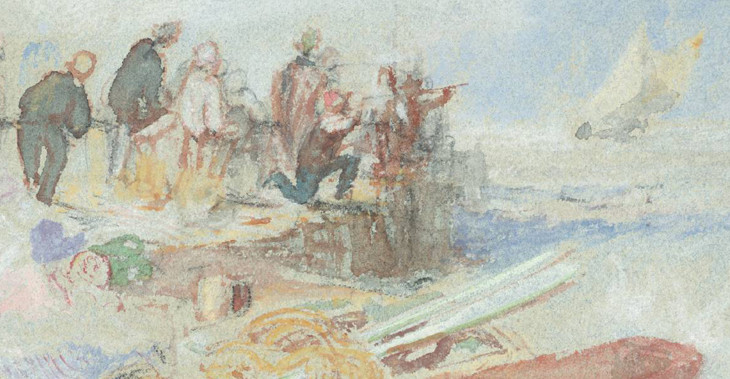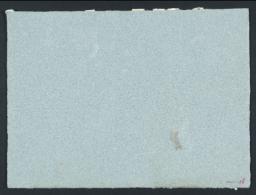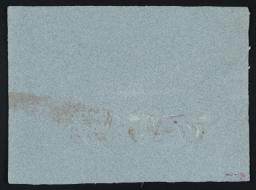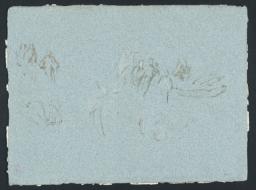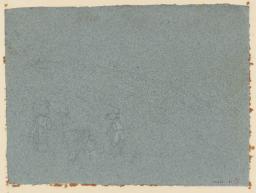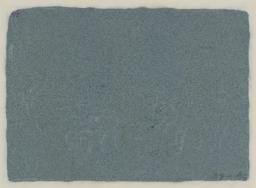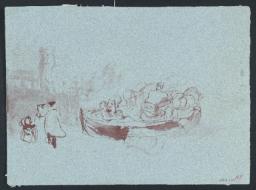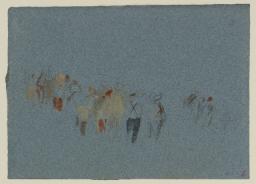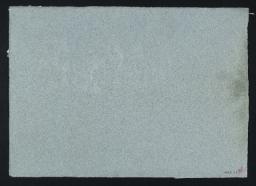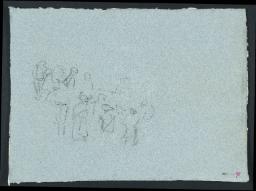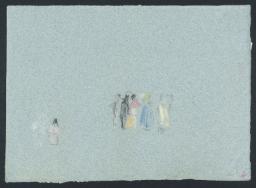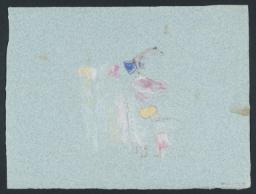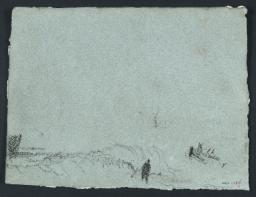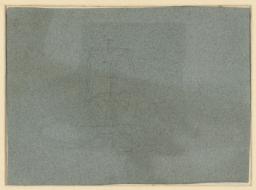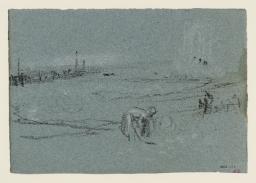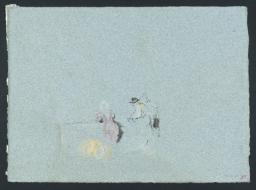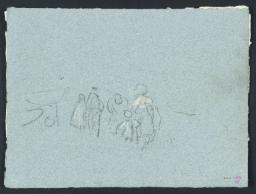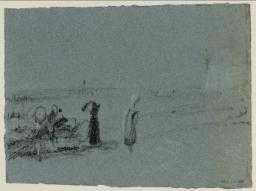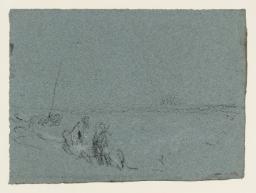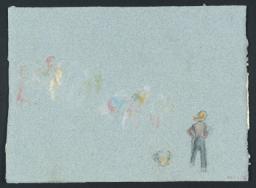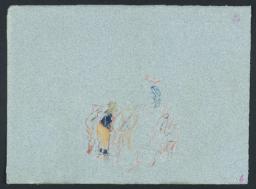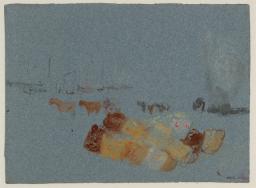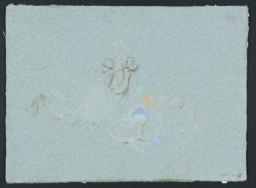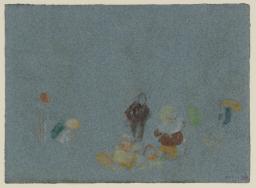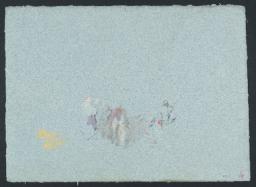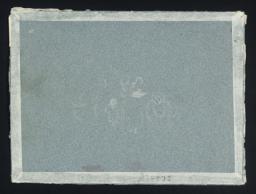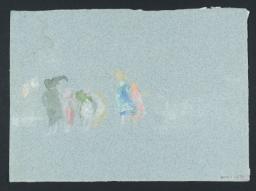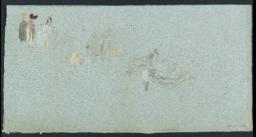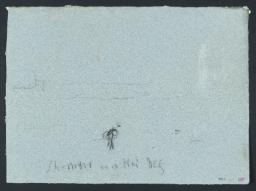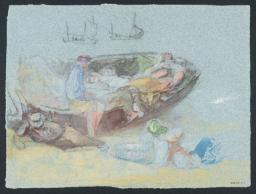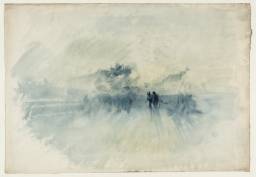From the entry
This small section comprises miscellaneous drawings of figures in unidentified or generic beach or shoreline settings, as yet of uncertain date and not connected with particular tours; sometimes the setting is blank or barely indicated, but inferred from the dress or attitudes of the figures. Many are depicted from the back, as if in candid poses while unaware of the artist’s presence, suggesting direct observation in at least some cases. Except for one which may be somewhat later, they are in combinations of pencil, chalk, gouache and watercolour on the small sheets of blue paper which Turner first used extensively in France in 1826, on the Isle of Wight (mostly Tate; Turner Bequest CCXXVII a, CCXXVIII) and at Petworth House (mostly Tate; Turner Bequest CCXLIV) in 1827, and for Continental subjects as late as 1840 (see the technical notes below). There are several more developed shore scenes on blue paper of similar dimensions, often with figure groups at work or play, in other collections. Most of the sheets here are drawn ...
D24591, D24592, D24619–D24624, D24626–D24633, D24763, D24790, D24795, D24797, D24798, D24810, D24930–D24934, D24937–D24942, D24944, D24946, D25059, D36315, D40106, D40112, D41491
Turner Bequest CCLIX 26, 27, 54–59, 61–68, 198, 225, 230, 232, 233, 245, CCLX 94–97, 97v, 98, 101–106, 108, 110, CCLXI 87, 87a, CCCLXV 25
Turner Bequest CCLIX 26, 27, 54–59, 61–68, 198, 225, 230, 232, 233, 245, CCLX 94–97, 97v, 98, 101–106, 108, 110, CCLXI 87, 87a, CCCLXV 25
This small section comprises miscellaneous drawings of figures in unidentified or generic beach or shoreline settings, as yet of uncertain date and not connected with particular tours; sometimes the setting is blank or barely indicated, but inferred from the dress or attitudes of the figures. Many are depicted from the back, as if in candid poses while unaware of the artist’s presence, suggesting direct observation in at least some cases. Except for one which may be somewhat later, they are in combinations of pencil, chalk, gouache and watercolour on the small sheets of blue paper which Turner first used extensively in France in 1826, on the Isle of Wight (mostly Tate; Turner Bequest CCXXVII a, CCXXVIII) and at Petworth House (mostly Tate; Turner Bequest CCXLIV) in 1827, and for Continental subjects as late as 1840 (see the technical notes below). There are several more developed shore scenes on blue paper of similar dimensions, often with figure groups at work or play, in other collections.1
Most of the sheets here are drawn from Turner Bequest sections CCLIX and CCLX, which Finberg characterised in his 1909 Inventory as ‘connected with the “French Rivers” series’ and dated to about 1830.2 Except where particular factors suggest a more specific date, they have each been given a range of about 1826–40 here. The technical exception is Figures in a Storm (D36315; Turner Bequest CCCLXV 25) a larger watercolour on conventional white paper included as a sort of coda to the theme, which may be as late as 1835–45.
Ian Warrell has noted a handful of similar blue paper works from Finberg’s ‘Petworth’ and ‘French Rivers’ sections definitely showing the beach and chain pier at Brighton in Sussex around 1827 (Tate D22772, D22773, D24815, D24836; Turner Bequest CCXLIV 110, 111, CCLIX 250, 271);3 another drawing, of fashionable women in bonnets by the sea, has also been associated with the resort (Tate D24935; Turner Bequest CCLX 99). Warrell has listed a further twenty sheets which might also show Brighton scenes and be associated with Turner’s 1827 stay at Petworth, about twenty miles away: Tate D24591, D24592, D24619, D24620, D24622– D24624, D24626–D24633, D24790, D24791, D24794, D24797, D24810 (Turner Bequest CCLIX 26, 27, 54, 55, 57–59, 61–68, CCLIX 225, 226, 229, 232, CCLIX 245).4
While observing that ‘[John] Constable’s studies of fisher-folk on Brighton beach show figures dressed in similar costumes’, Warrell notes that whether Turner’s sketches ‘were made in England or France is difficult to prove conclusively’;5 they are therefore included here as generic scenes (except D24791, which may be a Boulogne view, and D24794, perhaps Margate). The overall selection has been made up with about the same number of works again, compiled mainly through a process of visual comparison.6 Some of the figures here may also have been seen on the beach at Margate in Kent, which Turner spent much time overlooking in the 1830s as a paying guest of his subsequent companion Mrs Booth; see the Introduction to the Marine Dabblers sketchbook (Tate; Turner Bequest CCXLI) in the ‘Margate, Croydon and London c.1829–30’ section.
The sea and human activity on and beside it was major theme for Turner.7 Working scenes of fishermen on the shore stem from early in his career, in paintings such as Sun Rising through Vapour; Fishermen Cleaning and Selling their Fish, exhibited at the Royal Academy in 1807 (National Gallery, London),8 Fishmarket on the Sands – Hastings?, shown at the artist’s own gallery in 1810 (Nelson-Atkins Museum of Art, Kansas City),9 and the 1824 watercolour Hastings: Fishmarket on the Sands (Hastings Museum and Art Gallery).10 Among the studies here are scenes of fishermen working in boats or on the shore, on watch or resting, often with their characteristic sou’wester oilskin hats; see Tate D24592, D24619, D24620, D24623, D24624, D24626, D24628, D24632, D24763, D24795, D24930 and D24944 (Turner Bequest CCLIX 27, 54, 55, 58, 59, 61, 63, 67, 198, 230, 94, CCLX 108).
The period after the end of the Napoleonic Wars in 1815 saw the development of tourism both at home and abroad, and quicker means of travel to the Continent by steamship.11 As well as observing figures apparently relaxing on the beach or looking out to sea (see Tate D24591, D24630, D24797, D24798, D24931–D24934, D24939–D24942, D25059, D41491; Turner Bequest CCLIX 26, 65, 232, 233, CCLX 95–98, CCLX 103–CCLX 106, CCLX 97v, CCLXI 87), Turner would often have seen fellow travellers visiting resorts or in transit from them, giving the opportunity of discreet thumbnail sketches such as some of those seen here in Tate D24622, D24627, D24629, D24631, D24633, D24790, D24810 and D24937 (Turner Bequest CCLIX 57, 62, 64, 66, 68, 225, 245, CCLX 101); see also Tate D24944 (Turner Bequest CCLX 108).
Meanwhile, the potentially elegiac situation of figures on a beach, in the face of the vastness of the ocean, became an occasional theme in Turner’s paintings. There are the women bent double at sunset in Calais Sands, Low Water, Poissards Collecting Bait, exhibited at the Royal Academy in 1830 (Bury Art Museum);12 compare Tate D40106 and D24938 (CCLX 102). There is the boy and his leaping dog in The Evening Star, an unfinished painting of about that date (Turner Bequest, National Gallery, London);13 compare D24946 (CCLX 110). Later there are the squabbling children of the Margate scene The New Moon; or, ‘I’ve lost My Boat, You shan’t have Your Hoop’, exhibited at the Royal Academy in 1840 (Tate N00526);14 a very slight example here of what may be a lone figure or sail beneath the moon is D24621 (CCLIX 56). Perhaps the ultimate expression of this more desolate strain is not human but animal, the howling dog on the deserted beach under a crescent moon in the watercolour of about 1841, Dawn after the Wreck (Courtauld Galleries).15
Technical notes:
Turner had used blue paper (and others tinted or washed pink or brown) early in his career, in a conscious emulation ‘Old Master’ style in sketchbooks employed for working up pictorial compositions for major paintings, often with strong chiaroscuro effects through the use of dark chalk or ink and white highlights, such as the imposing Calais Pier book from the turn of the century (Tate; Turner Bequest LXXXI).16 The smaller Studies near Brighton sketchbook of 1796 (Tate; Turner Bequest XXX) includes more intimate studies of contemporary figures and shore scenes, comparable in spirit to some of the works here. In the mid 1820s, while continuing to use conventional sketchbooks of white paper, Turner adopted a practice of using small, neatly torn sheets of blue (or blue-grey) paper, sometimes working in pencil alone, but often with strong watercolour or gouache colours and/or white highlights in chalk or gouache. There is a ‘sea of blue and grey papers, all the same size, with no dates’ in the Turner Bequest,17 numbering well over a thousand sheets and still in the course of being researched, identified and reunited, as well as similar works in other collections.18
Turner made use of the sheets for his various ‘Rivers of Europe’, initially on the 1826 tour of Brittany and the Loire.19 Ian Warrell has discussed the cross-over between different subjects and media and the consequent issues in attempting to categorise and date the sheets on the basis of whether or not ink, gouache or other media were used.20 Many of the ‘French Rivers’ drawings on blue paper (Tate and elsewhere)21 were developed to the point where they were effectively complete and sufficiently detailed to be interpreted directly as engravings, whereas the East Cowes and Petworth drawings already mentioned had the less formal character of private sketches or memoranda.22 The slight treatment of the figures here is comparable with some of the Petworth material.
Andrew Wilton, J.M.W. Turner: His Life and Work, Fribourg 1979, pp.407–8 among nos.916–926, reproduced; see also p.408 no.927, reproduced, on buff paper; for Fishermen on the Shore, a blue paper work not listed in Wilton, see Lowell Libson Ltd: The First Five Years, London 2007, p.68, reproduced in colour p.[69].
See Finberg 1909, II, pp.789–805, CCLIX, ‘Water colours on blue paper: mostly connected with the “French Rivers” series’, and pp.806–13, CCLX, ‘Pencil and ink on blue paper: mostly connected with “French Rivers” series’.
See Ian Warrell in Martin Butlin, Mollie Luther and Warrell, Turner at Petworth: Painter and Patron, London 1989, p.120.
The author is very grateful to fellow Tate Turner cataloguers Alice Rylance-Watson and John Chu for intensive discussions in late October 2014, when the contents of the sections of separate sheets then remaining to be catalogued were largely drawn up.
See for example Paul Spencer-Longhurst, The Sun Rising through Vapour: Turner’s Early Seascapes, exhibition catalogue, Barber Institute of Fine Arts, University of Birmingham 2003, James Hamilton, Turner: The Late Seascapes, exhibition catalogue, Sterling and Francine Clark Art Institute, Williamstown 2003 and Christine Riding and Richard Johns eds., Turner & the Sea, exhibition catalogue, National Maritime Museum, London 2013.
Martin Butlin and Evelyn Joll, The Paintings of J.M.W. Turner, revised ed., New Haven and London 1984, pp.53–4 no.69, pl.79 (colour).
See for instance Ann Chumbley and Ian Warrell, Turner and the Human Figure: Studies of Contemporary Life, exhibition catalogue, Tate Gallery, London 1989, pp.48–53.
This discussion is a variation on the technical notes in the Introduction to the ‘East Cowes Castle’ subsection of the present author’s ‘Isle of Wight 1827’ section elsewhere in this catalogue.
Gerald Wilkinson, Turner’s Colour Sketches 1820–34, London 1975, p.80, where the principal sections are tabulated and summarised from Finberg 1909, II, and selected examples reproduced pp.80–98.
Wilton 1979, pp.406–23 nos.906–1043; for Turner’s use of opaque media on these tinted papers, see Andrew Wilton, Turner as Draughtsman, Aldershot 2006, pp.91–4; for technical analysis of the papers, see Peter Bower, Turner’s Later Papers: A Study of the Manufacture, Selection and Use of His Drawing Papers 1820–1851, exhibition catalogue, Tate Gallery, London 1999, pp.88–113.
How to cite
Matthew Imms, ‘Figures on a Beach c.1826–45’, December 2015, in David Blayney Brown (ed.), J.M.W. Turner: Sketchbooks, Drawings and Watercolours, Tate Research Publication, November 2016, https://www

